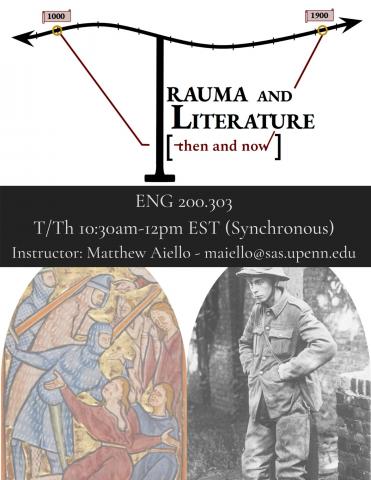Trauma & Literature (Then and Now)
Course Online: Synchronous Format
Are loss and violence transhistorical? The word trauma comes from the Greek verb “titrōskein,” meaning “to wound,” which led to the result of the act, the wound or “trōma” (“trauma”). While the physical wounding of the body is more in line with what the term meant in the premodern world, nowadays we mostly understand trauma to be a wound inflicted upon the mind. This course therefore asks students to think about how trauma changes (or stays the same) across vast swaths of time, what we need to change about how we approach the concept, and how experiences of tragedy and loss might be our strongest connection to the humanity of the distant past. What counts as trauma: when, for whom, and under what circumstances? How do catastrophic events demarcate time for societies (e.g. “pre” and “post” war), and how can movements in art, literature, and history be read as responses to these events? In this course we will interrogate these questions and the various social and material practices that cohere around notions of trauma by reading two distinct periods of English literary history: the medieval and the twentieth century.
Each 2-3 week module will pair a twentieth-century novel with a medieval text surrounding a shared theme: ecological grief, language and forms utterance, plague and pandemic, war and time, apocalyptic futures, etc. Some possible choices are Virginia Woolf’s Mrs. Dalloway (1925), chronicles from the First and Second Crusades (c. 1100), Toni Morrison’s Beloved (1987), Theresa Hak Kyung Cha’s Dictée (1982), Chaucer’s The Clerk’s Tale (c.1380), Leslie Marmon Silko’s Ceremony (1977), The Wife’s Lament (c. 1000), and others. No prior familiarity with these texts or with trauma theory is required.
This course fulfils sectors 1, 2, 3, and 6 of the English Major Core and is open to all students.

 Department of English
Department of English
